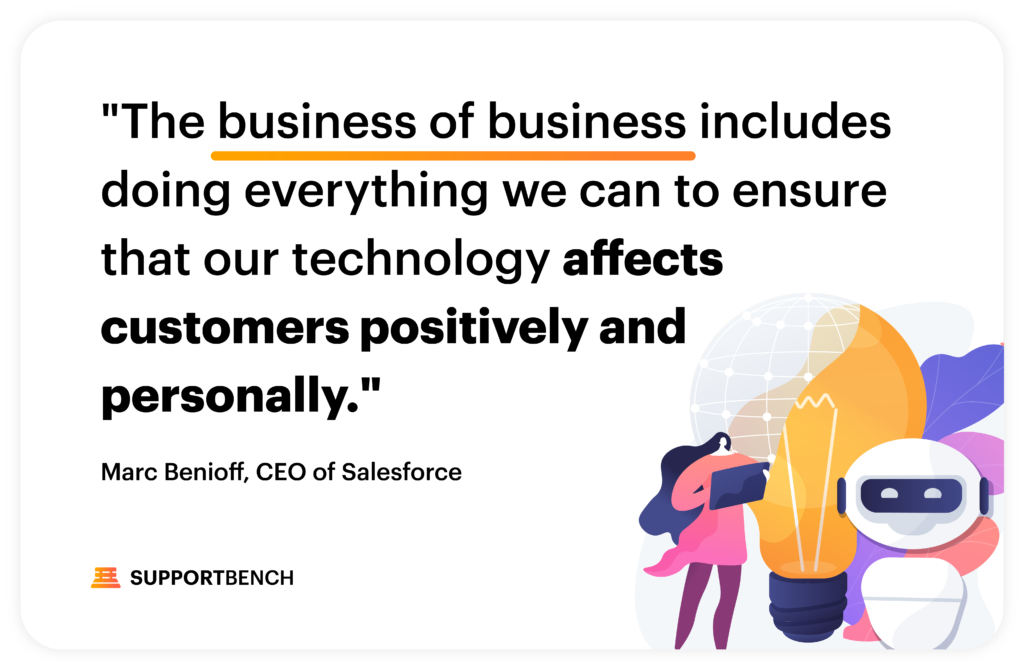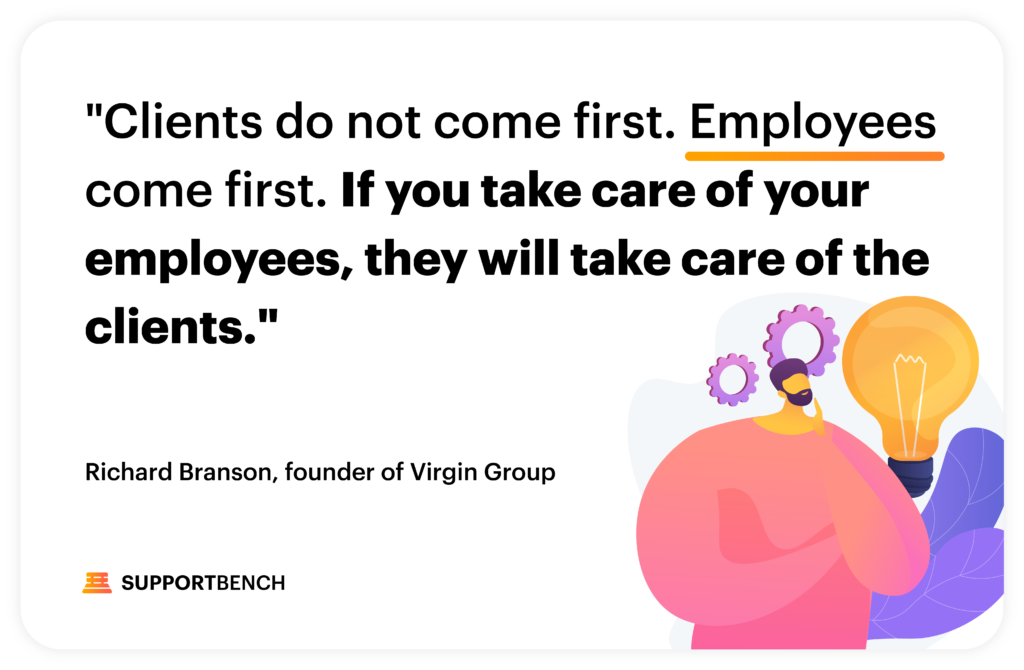In today’s hyper-connected and rapidly evolving business environment, exceptional customer service is not just a nice-to-have, but a vital component in sustaining growth, enhancing reputation, and ensuring customer loyalty. The old reactive model of customer service is being replaced by a more proactive, personalized, and streamlined approach. As part of this transformation, forward-thinking businesses are investing heavily in creating seamless customer support management systems that can adapt to the unique needs of their customers and deliver consistent, high-quality experiences.
In this article, we’ll dive deep into the latest trends shaping the future of customer support management. We’ll provide practical insights on how to implement these trends, peppered with insights from industry leaders and backed by the latest research and data.
Leveraging Artificial Intelligence

“AI is going to be extremely beneficial, and already is, to the field of customer support,” Elon Musk, CEO of Tesla and SpaceX, has said. Artificial intelligence (AI) is revolutionizing customer support management by automating routine tasks, offering predictive insights, and enhancing customer interactions. But how can your B2B enterprise effectively implement AI and leverage its full potential?
Implementation and Best Practices
Implementing AI in customer support begins with identifying the areas where automation can be of the greatest help. These could be routine tasks that consume valuable time, like sorting through support requests, or complex tasks that require predictive analysis, such as forecasting customer behavior or identifying potential issues before they escalate.
Once the target areas are identified, the next step is to choose the right AI tools. AI in customer support can take multiple forms – from chatbots that handle basic queries to advanced analytics systems that provide deep insights into customer behavior. The choice of tools depends on your specific needs, budget, and technological capability.
Training is another crucial component of AI implementation. Your support team needs to understand how to use AI tools effectively, how to interpret the insights they provide, and how to act on those insights. This will require ongoing training and support, as well as a culture that encourages experimentation and learning.
AI should be seen as a partner, not a replacement, for human agents. As Ginni Rometty, former CEO of IBM, rightly said, “Some people call this artificial intelligence, but the reality is this technology will enhance us. So instead of artificial intelligence, I think we’ll augment our intelligence.” AI is there to augment human abilities, not replace them. This understanding needs to be communicated clearly to your support team to alleviate any fears and foster a positive attitude towards AI.
When it comes to best practices, transparency stands out. When using AI in customer interactions, it’s important to inform customers that they are interacting with an AI. This creates trust and sets the right expectations.
Privacy is another major consideration. AI tools often need access to customer data to function effectively. It’s critical to ensure that these tools comply with privacy laws and regulations, and that customer data is handled with the utmost care.
Feedback and continuous improvement are also vital. AI tools should not be a set-it-and-forget-it solution. Regular monitoring and fine-tuning are necessary to ensure that they continue to deliver the desired results. Solicit feedback from both customers and support agents, and use this feedback to improve your AI systems.
AI offers immense potential for enhancing customer support, but it’s not a magic bullet. It requires thoughtful implementation, ongoing training and support, and a culture of continuous improvement. However, when done right, AI can transform your customer support management, delivering better experiences for your customers and a more efficient, enjoyable work environment for your support agents.
Adopting a Proactive Support Approach
As the adage goes, “Prevention is better than cure.” This couldn’t be more true in the realm of customer support. Moving from a reactive to a proactive support approach means anticipating and addressing customer issues before they become problems. As Mark Cuban, owner of the Dallas Mavericks, has noted, “Make your product easier to buy than your competition, or you will find your customers buying from them, not you.”
Implementation and Best Practices
Implementing a proactive support approach starts with understanding your customers. Utilize data analytics to track customer behavior and identify patterns that could indicate potential issues. This could mean monitoring product usage to detect if customers are using a feature incorrectly or leveraging customer feedback to identify common areas of confusion or dissatisfaction.
The next step is to develop an action plan to address these potential issues. This might involve creating resources such as how-to guides or FAQs to guide customers, sending targeted emails to customers who may be affected, or even reaching out directly to customers to offer assistance.
Proactive support also involves maintaining regular communication with customers. Instead of waiting for customers to contact you when they have a problem, maintain an ongoing dialogue. This can be done through regular check-ins, newsletters, social media engagement, and other forms of communication.
Now, let’s discuss some best practices for implementing a proactive support approach:
- Create a dedicated team: Proactive support requires a shift in mindset and operations. Consider creating a dedicated team to drive this initiative and ensure it gets the attention and resources it needs.
- Use the right tools: Technology can greatly facilitate proactive support. Tools like predictive analytics, customer health scoring, and automated alerts can help you anticipate and address issues before they escalate.
- Leverage AI: AI can play a key role in proactive support by analyzing vast amounts of data and predicting customer behavior. AI can also automate routine proactive support tasks, freeing up your team to focus on more complex issues.
- Educate your customers: Empower your customers with the knowledge and resources they need to use your product effectively. This could involve creating a comprehensive knowledge base, offering webinars or tutorials, or providing in-product tips and guidance.
- Listen to your customers: Proactive support is all about understanding and anticipating your customers’ needs. Make it a habit to solicit customer feedback and listen to what your customers are saying on social media, review sites, and other platforms.
- Continually measure and improve: Like any other business initiative, proactive support needs to be continually monitored and improved. Establish key performance indicators (KPIs) to measure the effectiveness of your proactive support efforts and use this data to drive ongoing improvements.
Adopting a proactive support approach requires effort and commitment, but the rewards are well worth it. By anticipating and addressing customer issues before they become problems, you can enhance the customer experience, boost customer loyalty, and ultimately, drive growth for your B2B enterprise.
Creating Personalized Experiences

Marc Benioff, CEO of Salesforce, emphasizes the importance of personalized experiences, stating that “The business of business is improving the state of the world. This includes doing everything we can to ensure that our technology affects customers positively and personally.” Personalization plays a pivotal role in enhancing customer support by making customers feel valued and understood.
Implementation and Best Practices
To create personalized customer experiences, begin by gathering as much information as you can about your customers. This could be through data collection tools, customer surveys, or tracking customer interactions. The more you know about your customers, the better you can tailor your services to meet their needs.
Use this data to personalize your interactions with customers, from using their name in communications to tailoring your support solutions to their specific needs. The right customer support platform can facilitate this process by offering features like customer profiles, data analysis, and tailored communication templates.
Here are some best practices to create more personalized experiences in a B2B enterprise customer support context:
- Collect relevant customer data: Use a variety of methods to gather information about your customers, including customer surveys, data collection tools, and tracking customer interactions. Be transparent about your data collection practices and comply with data privacy regulations.
- Use customer data wisely: Leverage the data you collect to create personalized customer experiences. This could include using the customer’s name in communications, understanding their product usage to anticipate their needs, or tailoring your responses based on their previous interactions.
- Invest in a robust customer support platform: Choose a customer support platform that offers features for personalization, such as customer profiles, data analysis, and tailored communication templates.
- Train your support team: Equip your support team with the skills and tools they need to deliver personalized support. This could include training on how to use customer data, how to personalize communications, and how to tailor support solutions to individual customers’ needs.
- Measure the effectiveness of your personalization efforts: Regularly assess the impact of your personalization efforts on customer satisfaction and support metrics. Use this feedback to continuously refine your approach.
Remember, personalization is about making customers feel valued and understood. By providing personalized experiences, you can not only enhance customer satisfaction but also build lasting relationships with your customers. In a world where businesses are increasingly seen as impersonal, a touch of personalization can set your support services apart.
Emphasizing Omnichannel Support
Steve Jobs once said, “You’ve got to start with the customer experience and work backward toward the technology – not the other way around.” In the era of the digital revolution, customers expect to connect with businesses seamlessly, regardless of the channel. Implementing an effective omnichannel strategy is vital for delivering a unified customer experience across multiple touchpoints.
Implementation and Best Practices
To implement omnichannel support, start by identifying all the channels your customers use to connect with you – it could be email, phone, social media, live chat, or in-app messaging. Then, ensure your support team can handle queries from these channels efficiently and seamlessly.
Invest in a robust customer support platform that supports multiple channels and ensures a seamless transition between them. This will allow your support team to have a complete view of customer interactions, regardless of the channel they use.
Here are some best practices to enhance your omnichannel support strategy:
- Understand your customers’ preferred channels: Regularly collect feedback from your customers to understand their preferred channels and adapt your strategy accordingly.
- Consistency is key: Ensure that your brand’s voice and message are consistent across all channels. This consistency will enhance the customer experience and build trust in your brand.
- Invest in the right technology: A robust customer support platform is essential for providing efficient omnichannel support. It should offer features like integrated ticketing systems, shared team inboxes, and easy transition between different channels.
- Train your team: Your support team should be trained to handle customer queries across different channels. They should also know how to use your customer support platform efficiently.
- Track and measure performance across channels: Use data analytics to track and measure the performance of your customer support across different channels. This will help you identify areas for improvement and adapt your strategy accordingly.
By emphasizing omnichannel support, you can ensure that your customers receive a consistent and seamless support experience, regardless of the channel they choose. This not only enhances the customer experience but also increases the efficiency and effectiveness of your support team.
Focusing on Employee Experience

Richard Branson, founder of Virgin Group, famously said, “Clients do not come first. Employees come first. If you take care of your employees, they will take care of the clients.” This perspective emphasizes the direct correlation between employee experience and customer satisfaction, a connection that cannot be overlooked when creating a seamless customer support management system.
Implementation and Best Practices
Improving the employee experience begins by recognizing that your customer support representatives are the frontline ambassadors of your brand. Investing in their skills, tools, well-being, and growth will directly influence the customer experience.
Start by conducting regular check-ins with your team members to understand their challenges and provide solutions. Equip them with the tools and training necessary to deliver efficient support, and create a positive work culture that recognizes and rewards their contributions.
Here are some best practices to enhance employee experience in a B2B enterprise customer support context:
- Invest in training: Regular training sessions will ensure that your customer support representatives have the necessary skills to handle customer queries and are up-to-date with your products and services.
- Provide the right tools: A robust customer support platform will enable your team to manage customer queries efficiently. It should provide features like automated ticketing, integrated communication channels, and data analytics for tracking performance.
- Promote a positive work culture: Recognition and appreciation can go a long way in boosting employee morale. Promote a culture that values the contributions of your customer support team and rewards them appropriately.
- Offer career growth opportunities: Regular performance reviews and opportunities for professional development can motivate your team and help them grow in their roles.
- Maintain open communication: Regular check-ins and open communication channels will allow you to understand the challenges faced by your team and provide timely solutions.
By focusing on the employee experience, you will not only increase employee satisfaction but also enhance customer support services. Happy employees translate to happier customers, and investing in your team is one of the most effective ways to create a seamless and efficient customer support management system.
Summing it all up
Creating a seamless customer support management system is not just about solving customer problems but doing so efficiently and proactively, enhancing customer relationships along the way. By adopting cutting-edge technology like AI and Machine Learning, businesses can optimize support operations and leverage data for informed decision-making. Simultaneously, personalizing customer interactions, promoting omnichannel communication, and focusing on the employee experience can collectively drive a robust and streamlined customer support system.
Supportbench is transforming the way businesses approach customer support management. With its holistic suite of features, including dynamic SLAs, AI-driven sentiment analysis, and customizable dashboards, businesses can craft seamless customer experiences. Emphasizing on data-driven innovation and autonomous support infrastructure, Supportbench allows organizations to stay ahead of the curve and improve performance continually.
By focusing on employee experience, Supportbench understands the importance of keeping the support team motivated and satisfied. Their platform offers growth opportunities, promotes a positive work culture, and provides the right tools for efficient support management. As a result, Supportbench is fostering happier support teams, leading to more satisfied customers and a seamless customer support management system.















